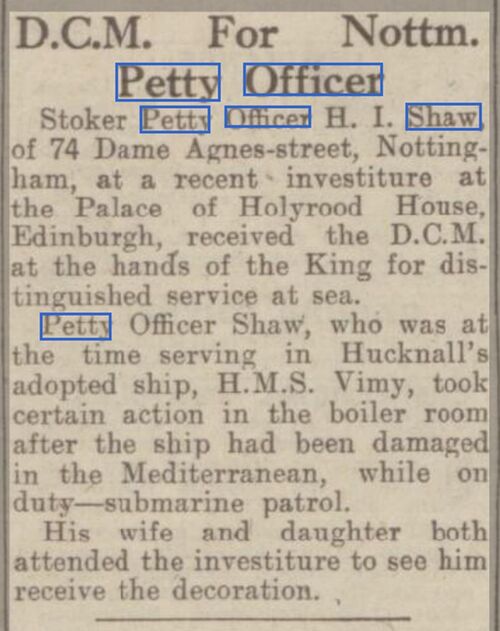Auction: 24001 - Orders, Decorations and Medals
Lot: 135
A 'Battle of the Atlantic 1942' D.S.M. group of eight awarded to Stoker Petty Officer H. I. Shaw, Royal Navy, who saw service at Jutland with St. Vincent and returned to sea in the Second World War for action with Vimy
Distinguished Service Medal, G.VI.R. (K.7866 H. I. Shaw. Sto. P.O. R.N.); 1914-15 Star (K.7866. H. I. Shaw, L. Sto., R.N.); British War and Victory Medals (K.7866 H. I. Shaw. S.P.O R.N.); 1939-45 Star; Atlantic Star, with France and Germany clasp; Defence and War Medals 1939-45, light pitting and wear, overall very fine (8)
D.S.M. London Gazette 22 December 1942, the original recommendation states:
'For initiative and courage when U.162 was sunk. This Stoker Petty Officer was in charge of the For'ard fire and repair party in the galley flat. Collision with the U-boat damaged and stopped the Port fan engine in No 1 Boiler Room, causing a back flash from the furnace and dense volumes of smoke on the upper deck. Realising that the Stoker Petty Officer on watch was inexperienced, Shaw dashed down on his own initiative, took charge and allayed panic.'
Harold Isaac Shaw was born at St. Mary’s Nottingham on 21 November 1889 and enlisted with the Royal Navy on 3 August 1910 as Stoker Class II. Serving afloat for the first time with H.M.S. Renown he was posted to the Battleship St. Vincent the following year. Advanced Leading Stoker just prior to the outbreak of the Great War Shaw was to serve with St. Vincent for the majority of the conflict.
Jutland
This warship formed part of Admiral Jellicoe’s Grand Fleet during the Battle of Jutland, with the 1st Battle Squadron. The vessel was 20th in the line of battle and fired a total of 98 rounds of 12-inch ammunition, first targeting the light cruiser Wiesbaden before switching targets to the battlecruiser Moltke. They managed to land two hits upon her, the first glancing off the bridge and destroying the sick bay, the other landing behind the main battery and penetrating the armour, causing serious damage.
After the Battle Shaw remained with St. Vincent for another year before being posted to the destroyer Tartar in November 1917. He was still with her the next year when she struck the merchant ship Ardgantock, off Blyth, Northumberland, sinking her. Shaw remained in service for some time after the end of the war, but was finally discharged ashore on 9 June 1923 from H.M.S. Conqueror.
H.M.S. Vimy
Returning to service on the outbreak of the Second World War he was posted to the destroyer Vimy on 8 November 1940 and, with the exception of a short spell ashore the next year, remained with her for the rest of the war. This vessel was heavily involved in the Battle for the Atlantic, seeing a great deal of convoy and anti-submarine duty. One of her greatest successes was the destruction of U-162 in September 1942. The ships commander gave a good description of the battle in his report stating:
‘…However, U-Boat was soon sighted and fire opened with H.E. D.A., from “A” gun. The second round hit, and is stated by prisoners to have burst inside the U-Boat. Fire was then checked so as to observe the U-Boat better for ramming (gun flashes were blinding). 2 bright red flares were then fired in our direction with about half a minute interval between them. These were partially blinding and obscured the U-Boat from view at a critical moment. Prisoner states that red flare was the signal to abandon ship. (it also happened to be the current recognition signal for British Submarines).
When next visible, the U-Boat was broad on the port bow and about 100 yards away. “Vimy”, travelling at full speed under full helm in an attempt to ram, was listing to starboard at an alarming angle, so that guns could not depress far enough, and the flickering searchlight was not much use. “Vimy” was passing ahead of the U-Boat and it was clear that she was herself about to be rammed near the Engine Room. The order was then given “Hard a starboard, and Full Astern Both”. The U-Boat brought up alongside at a fine angle, denting “Vimy’s” port propeller hit her aft and was badly damaged, and the ship was then stopped.
Most of the U-Boat’s crew seemed to be already in bathing trunks, ready to abandon ship, and it occurred to me that this might be a ruse to make us think she was sunk when in fact she still had sufficient personnel on board to dive and escape. Accordingly, I fired one depth charge set to 50 feet from the port thrower, and went ahead. This apparently hurled most of the men into the water. The U-Boat was last seen with about one foot of conning tower showing, and heeling well over to port. No further asdic or R.D.F. contact was obtained as the 20 Volt System failed. Rescue operations were then commenced, using snowflakes and searchlight.’
(The official narrative of the sinking of U-162, Lieutenant-Commander H. G. D. de Chair, refers)
Shaw remained with the vessel when she was posted to North-West Europe to take part in Operation Neptune, supporting the Normandy Landings in 1944. After the success of the landings she went on to undertake an anti-submarine role in the channel. It was at this time that a newspaper reported Shaw receiving his medal at a ceremony in Buckingham Palace (Nottingham Evening Post 26 September 1944, refers). He was demobilised before the end of the war on 8 December 1944; sold together with copied research including service records, recommendation for award and information on the service of H.M.S. Vimy.
Subject to 20% VAT on Buyer’s Premium. For more information please view Terms and Conditions for Buyers.
Estimate
£2,000 to £2,400
Starting price
£1800









